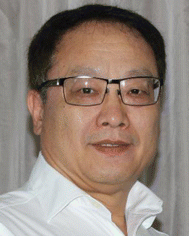Design and characterization of flexible electrode materials
Xiu Song (George)
Zhao
 *a,
Hui Ying
Yang
*a,
Hui Ying
Yang
 *b and
Qiang
Li
*b and
Qiang
Li
 *a
*a
aQingdao University, China. E-mail: chezxs@qdu.edu.cn; liqiang@qdu.edu.cn
bSingapore University of Technology and Design, Singapore. E-mail: yanghuiying@sutd.edu.sg
Flexible electrode materials form the cornerstone of technologies that blend seamlessly in our everyday lives. Unlike their rigid counterparts, flexible electrodes are able to stretch, bend and conform to uneven surfaces without ever losing functional integrity. The transformative nature of these electrodes has brought about many innovations in healthcare, environmental remediation, energy storage and wearable electronics. To say that flexible electrodes have revolutionized the technological landscape is truly an understatement.
Healthcare, for example, benefits greatly from the use of flexible biosensors which adhere to the curvilinear contours of human skin. These sensors can capture minute physiological changes to a patient's condition and enable more intimate monitoring of a patient. Flexible biosensors can also help evaluate an athlete's performance during training and provide biomechanical information crucial to developing future training regimes. Not only do flexible biosensors perform better, they also offer an unparalleled degree of comfort compared to traditional sensors requiring adhesives to stick onto skin. Another area of application that has seen monumental growth and interest is consumer electronics, specifically in energy storage. With the proliferation of flexible displays, rollable televisions, fitness trackers and smart textiles comes a need for energy storage solutions that can accommodate large omnidirectional strain/stress and possess high energy density.
In this themed collection, a comprehensive review of anode-free lithium-metal batteries for flexible systems is provided by Tang et al. (https://doi.org/10.1039/D4TA02003K). The review delves deep into the various components of lithium-metal batteries in the context of flexible systems and presents a realistic outlook of the various manufacturing strategies to achieve flexible lithium-based batteries. Tang et al. had analysed various promising electrolyte choices, recounted a number of coating strategies to achieve uniform lithium deposition and had concluded that the development of novel gel polymer electrolytes and ion-conducting artificial solid-electrolyte interphase layers represent the most promising directions. In a related vein, Li's group (https://doi.org/10.1039/D4TA02143F) have developed a strategy of fabricating active materials comprising of electroactive Co(OH)F core nanowire arrays encased in a lithiophilic CoS2 shell to achieve homogenous lithium nucleation and deposition in flexible lithium-metal batteries. In their work, the CoS2 shell layer undergoes lithiation to form Co/LiS2 in which the LiS2 phase is complemented by Co to achieve uniform lithium deposition and high charge transfer. Using this unique configuration, they are able to achieve excellent cycling stability at a low overpotential of 13 mV across 2400 h of cycling. A full cell assembled with LiFePO4 delivered an impressive 1500 cycles at 1 C.
While energy density and cycling stability are important parameters to consider, energy storage solutions for human-interactive devices also need to be able to integrate smoothly without disrupting the functionality of other components. This can be accomplished through a single streamlined manufacturing process. In Liu's work (https://doi.org/10.1039/D4TA02127D), a flexible, hemispherical eye sensor was fabricated using laser-scribing-assisted spray coating to provide independent monitoring of intraocular pressure. This novel application of flexible electrodes used the same Ti3C2Tx MXene materials for two major components: a micro-supercapacitor powering the device and the strain sensor responsible for detecting changes in intraocular pressure. These components were integrated conveniently on a deformable P(VDF-TrFE) substrate and can be worn over an eye like a contact lens. Liu reported a specific capacitance of 32 mF cm−2 with an energy density of 10 mW h cm−2 for the micro-supercapacitor and a high sensitivity of 0.014 mm Hg−1.
In most research works, the flexibility of an electrode is usually a mechanical property complementary to its original functionality. Yet there are instances where mechanical deformations of a material can yield improved or additional functions. This is capitalized in Hasimoto's work (https://doi.org/10.1039/D4TA02042A) where large MoS2 sheets were prepared on stretchable gold substrates for improved catalytic performance in hydrogen evolution reactions. Hasimoto et al. had leveraged on the principles of defect engineering to induce the formation of aligned cracks along the basal plane of MoS2 sheets. Through a sequence of theoretical simulations and localised characterization, Hasimoto and his co-workers confirmed that electrocatalytic activity was indeed improved after the electrodes had been stretched. An impressive reduction of overpotential to 352 mV was measured at 10 mA cm−2, while cycling remained stable up to 500 cycles. The relative ease of preparing these materials is promising for scalable production.
While the majority of articles remained focused on energy storage, reflecting the enthusiasm of the scientific community at large, we are also seeing an expansion of flexible electrode applications across other disciplines, such as in desalination (https://doi.org/10.1039/D4TA00236A), CO2 electrolysis (https://doi.org/10.1039/D4TA01994F) and mechanical sensing (https://doi.org/10.1039/D3TA06257K). We hope that the collection of articles will provide readers with a bird's eye view of the exciting possibilities in the field of flexible electrode materials and aid them in developing their own research strategies. Finally, we would like to thank all contributing authors, reviewers and editorial staff in the production of this current themed collection.
| This journal is © The Royal Society of Chemistry 2024 |



